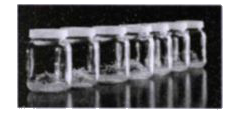The rate o growth of bacteria is proportional to the number present . IT intially, there were 1000 bacteria and the number doubles in 1 hours. Find the number of bacteria after 212 hours . [ take √2=1.414]
Let x be number of bacteria present at time 't' ∵ The rate of growth of bacteria is proportional to the number present, we get
dxdt=∝x
∴dxdt=kx
∴dxx=k.dt
Integrating both sides,
∫dxx=k∫dt
∴logx=kt+C .......(i)
when t=0, x=1000
∴ we get,log1000=k×0+C
∴C=log1000
∴ Equation (i) can be written as
logx=kt+log100 ......(ii)
when t=1, x=2000
∴ Equation (ii) can be written as,
log2000=k.1+log1000
⇒k=log2000−log1000
⇒k=log(20001000)=log2
⇒k=log2
∴ Equation (ii) can be weitten as
logx=t.log2+log1000 .......(iii)
when t=212=52, we get
⇒logx=52.log2+log1000
=log(25/2)+log1000
=log(4√2)+log1000
=log(4√2×1000)
=log(4000×√2)
=log(4000×1.414)
⇒logx=log(5656)
⇒x=5656
Thus, after 212 hrs, number of bacteria =5656.
Topper's Solved these Questions
- JULY 2018Book:GURUKUL PUBLICATION - MAHARASHTRA PREVIOUS YEAR PAPERSChapter: JULY 2018Exercise:SECTION II
Explore 20 Videos
- JULY 2017Book:GURUKUL PUBLICATION - MAHARASHTRA PREVIOUS YEAR PAPERSChapter: JULY 2017Exercise:SECTION - II
Explore 20 Videos
- MARCH 2014Book:GURUKUL PUBLICATION - MAHARASHTRA PREVIOUS YEAR PAPERSChapter: MARCH 2014Exercise:SECTION-II
Explore 20 Videos
Similar Questions
Knowledge Check
The rate of increase in the number of bacteria in a certain bacteria culture is proportional to the number present. If in 5 hrs the number triples, then in 10 hrs, the number of bacteria present is
A18 times the originalB12 times the originalC6 times the originalD9 times the originalRead the following text and answer the following questions on the basis of the same: The rate of increase in the number of bacteria in a certain bacteria culture is proportional to the number present. Given that the number triples in 5 hours.

If N0 is the initial count of bacteria, after 10 hours the count is __________ .A15log3B3logN0C9N0D2N0Read the following text and answer the following questions on the basis of the same: The rate of increase in the number of bacteria in a certain bacteria culture is proportional to the number present. Given that the number triples in 5 hours.

If 'N' is the number of bacteria, the corresponding differential equation is ____________ .AdNdt=KtBdNdt=KNCdKdt=NDdKdN=t
In a certain culture of bacteria, the rate of increase is proportional to the number present. If it is found that the number doubles in 4 hours, find the number of times the bacteria are increased in 12 hours.
View SolutionBacteria increases at the rate proportional to the number of bacteria present. If the original number N doubles in 3 hours, find in how many hours the number of bacteria will by 4N ?
View SolutionThe rate of increase of the bacteria in a culture is proportional to the number of bacteria present and it is found that the number doubles in 6 hours. Prove that the bacteria becomes 8 times at the end of 18 hours.
View SolutionThe rate of increases of bacteria in a certain culture is proportional to the number present. If it doubles in 5 hr., then in 25 hr., its number would be
View SolutionThe rate of increase in the number of bacteria in a certain becteria culture is propotional to the number present at that time. If initiallly there are 300 bacteria and after 2 hours, the bacteria polulation is increased by 20% then after 24 houre, the number of bacteria are (log1.2=0.18232,e2.18784=8.9166)
View Solution

